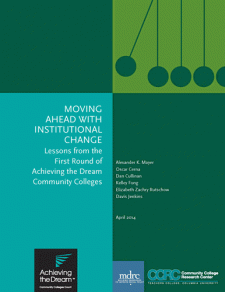Lessons from the First Round of Achieving the Dream Community Colleges
Achieving the Dream

Overview
Community colleges enroll almost half of all U.S. undergraduate students, yet the majority of these students leave without earning a degree or certificate or transferring to another institution to continue their studies. As a result, they risk losing the opportunity to learn and to earn a livable wage.
Achieving the Dream: Community Colleges Count was a multiyear national initiative to help more community college students succeed. The initiative was particularly concerned about student groups that traditionally have faced the most significant barriers to success, including low-income students and students of color.
Achieving the Dream worked on multiple fronts, including changes in the institutional practices and policies at participating colleges; research into effective practices at community colleges; public policy work; and outreach to communities, businesses, and the public. MDRC was one of the founding partners in the initiative.
Additional Project Details
Agenda, Scope, and Goals
Through Achieving the Dream, participating colleges were expected to undertake a careful examination of student transcripts and other data to identify factors that may contribute to or impede students’ academic success. From this analysis, they developed and implemented plans to improve instruction and other college services. Colleges were also encouraged to closely monitor students’ progress and share their findings with other participants in the initiative. Through these institutional reforms, Achieving the Dream expected colleges to see measurable improvements in student outcomes, such as completion of developmental (remedial) courses, semester-to-semester retention, and graduation.
Lumina Foundation for Education provided funding for the initiative’s startup and continued to support the initiative as it has transitioned into an independent nonprofit. College Spark Washington, The Heinz Endowments, Houston Endowment Inc., Kresge Foundation, and The Bill & Melinda Gates Foundation were just a few of the more than 20 foundations that also provided additional funding to help the initiative.
In 2009, the Bill and Melinda Gates Foundation and Lumina Foundation for Education funded the Developmental Education Initiative (DEI) to expand developmental education interventions in 15 community colleges participating in Achieving the Dream. MDRC published a report on the DEI in January 2013.
Design, Sites, and Data Sources
Achieving the Dream included nearly 200 colleges in 30 states and the District of Columbia. The original 26 community colleges, which began working with the initiative in 2004, were located in five states: Florida, New Mexico, North Carolina, Texas, and Virginia. These states were chosen because they had community colleges that enrolled large numbers of low-income students and students of color — student groups that traditionally face the most significant barriers to success. These states also demonstrated interest in implementing policies that promote access to and success in community colleges. Over 200 colleges across the country joined the initiative.
When joining the initiative, colleges were expected to evaluate their own student data — including data on their overall student population as well as data disaggregated for particular racial, ethnic, and income subgroups — to identify achievement gaps and priority areas for reform. They were also encouraged to gather input from their student bodies, faculties, staffs, and communities. Using this information, college officials were then expected to adopt strategies to create real changes in specific practices, such as a sharper focus on effective developmental education, as well as less tangible shifts in attitudes and approaches, such as strengthening institutional research capacity.
Starting in late 2005, MDRC began studying program implementation at the 26 Round 1 colleges. In 2006 and 2009, MDRC and its partners visited the Round 1 colleges, documenting the reforms that each college had undertaken and conducting interviews with administrators and faculty members to measure changes in attitudes and practices at the colleges. Qualitative data from these visits were combined with student performance indicators, with findings summarized in a baseline report released in May 2007 and an interim report on the Round 1 colleges’ progress in February 2011.
MDRC, together with its evaluation partner, the Community College Research Center (CCRC), also published a number of other reports on colleges’ programs, strategies, and progress in Achieving the Dream, including a cost study analyzing colleges’ financial contributions to the initiative; a qualitative study of minority men in Achieving the Dream colleges; an analysis of faculty members and administrators’ use of data on student outcomes; a baseline and final report on Round 3 colleges in Washington State and Pennsylvania that joined the initiative in 2006; three impact studies of a staff-to-student mentoring program, a student success course, and learning communities; and three case studies on colleges’ strategies and interventions. In 2014, MDRC and the Community College Research Center (CCRC) will also produce a final report documenting the progress of the 26 Round 1 colleges. These reports use such data sources as field visits to the colleges; a follow-up survey of administrators and faculty members; and analysis of the student outcome data that the participating colleges submitted as part of their work in the initiative.
Featured Work
A Case Study of Two Community College Programs Designed to Accelerate Students Through Developmental Math






